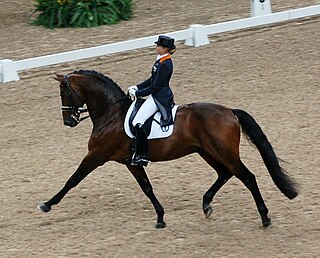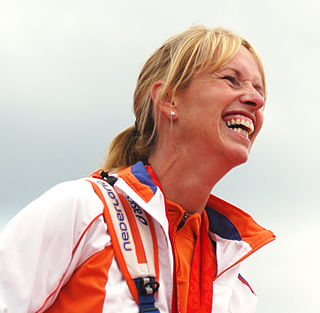
Dressage is a form of horse riding performed in exhibition and competition, as well as an art sometimes pursued solely for the sake of mastery. As an equestrian sport defined by the International Equestrian Federation, dressage is described as "the highest expression of horse training" where "horse and rider are expected to perform from memory a series of predetermined movements".
Equestrian competitions at the 1968 Summer Olympics in Mexico City, Mexico featured team and individual competitions in show jumping, eventing, and dressage. Mexico City proved a challenging site since it was 2,300 meters above sea level, resulting in 30% less oxygen in the air. The horses at the 1955 Pan American Games, which was also held in Mexico City, arrived a few weeks before the Games to adjust, but had difficulty in the competition. However, racehorses that competed at the same location and who were shipped in the day before, and left the day after the race, performed fine. It was discovered that although horses would adjust immediately to the high altitude during the first few days after arrival, they showed weakness and decreased performance around Day 10, which continued to Day 20. Therefore, nations were advised to ship in horses 3–4 weeks before the competition, which would allow them time to recover from the long travel, as well as adjust to the difference in altitude. Argentina, Ireland, and the USSR were the first to ship horses over, who arrived mid-September. France and Germany were the last countries to send their horses, who arrived 28 September 20 days before the competition was to start.

Theodora Elisabeth Gerarda "Anky" van Grunsven is a Dutch dressage champion who is the only rider to record three successive Olympic wins in the same event. Along with her Olympic successes, she has won numerous medals at the World Equestrian Games (WEG), and is the only rider to have competed at every WEG since they began in 1990. Between 1990 and 2006, she competed at the Games in dressage, but in 2010 she was named as part of the Dutch reining team, marking a major change in discipline.

The equestrian events at the 1928 Summer Olympics included dressage, eventing, and show jumping. All three disciplines had both individual and team competitions. The competitions were held from 8 to 12 August 1928. Teams were now fielded by three riders, rather than four, the purpose being to reduce pressure on national federations to find that many riders in order to compete for team medals. Riders had to be considered amateurs, which was defined as either an actively serving professional officer, or as a gentleman rider as defined by the rules of that rider's national governing body. A total of 113 entries were present from 20 nations: Argentina, Austria, Belgium, Bulgaria, Czechoslovakia, Denmark, Finland, France, Germany, Hungary, Italy, Japan, the Netherlands, Norway, Poland, Portugal, Spain, Sweden, Switzerland, and the USA. This was the first appearance for Hungary, Japan and Argentina in equestrian events at an Olympics. Additionally, after being shut out from two Olympic competitions, Germany also returned to the Games to win a few medals in the equestrian events.

The equestrian events at the 1956 Summer Olympics were held in Stockholm due to the Australian quarantine regulations and included dressage, eventing, and show jumping. All three disciplines had both individual and team competitions. The competitions were held from 11 to 17 June 1956 at Stockholm Olympic Stadium. There were 158 entries from 29 National Olympic Committees: Argentina, Australia, Austria, Belgium, Brazil, Bulgaria, Cambodia, Canada, Denmark, Egypt, Finland, France, Germany, Great Britain, Hungary, Ireland, Italy, Japan, Netherlands, Norway, Portugal, Romania, Soviet Union, Spain, Sweden, Switzerland, Turkey, USA and Venezuela. This would be the first appearance for Australia, Cambodia and Venezuela in equestrian events.
The equestrian events at the 1972 Summer Olympics in Munich included show jumping, dressage and eventing. All three disciplines had both individual and team competitions. The equestrian competitions were held at 3 sites: an existing equestrian facility at Riem for the individual show jumping and eventing competitions, the Olympic Stadium in Munich for the Nations Cup, and Nymphenburg, a Baroque palace garden, for the sold-out dressage. 179 entries, including 31 women, competed from 27 countries: Argentina, Australia, Austria, Belgium, Bolivia, Bulgaria, Brazil, Canada, Chile, Denmark, the German Democratic Republic (GDR), France, the Federal Republic of Germany (FRG), Great Britain, Hungary, Ireland, Italy, Japan, Mexico, the Netherlands, Poland, Portugal, the Soviet Union, Spain, Sweden, Switzerland, and the United States. The youngest participant was Kurt Maeder from Switzerland at 19 years old, while the oldest rider was Lorna Johnstone from Great Britain at 70 years old.

The equestrian events at the 1964 Summer Olympics in Tokyo included show jumping, dressage and eventing. All three disciplines had both individual and team competitions. The competitions were held from 16 to 24 October 1964. These events took place at Karuizawa, which would become the first city to host Summer and Winter Olympic event when it hosted the curling events for the 1998 Winter Olympics in Nagano.

The equestrian events at the 1960 Summer Olympics in Rome included dressage, eventing, and show jumping. Eventing and show jumping presented both individual and team medals, dressage presented only individual medals. The competitions were held from 5 to 11 September 1960. 159 entries, including 8 women, competed from 29 nations: Argentina, Australia, Austria, Belgium, Brazil, Bulgaria, Canada, Czechoslovakia, Denmark, Egypt, France, Germany, Great Britain, Hungary, Ireland, Italy, Japan, Korea, New Zealand, Poland, Portugal, Romania, Soviet Union, Spain, Sweden, Switzerland, Turkey, Uruguay, and the USA. The youngest participant was Min Gwan-Gi from South Korea at 18 years old, while the oldest rider was Lilian Williams from Great Britain at 65 years old.

Equestrian sports were first included in the Olympic Games in the Summer Olympics of 1900 in Paris. They were again included in 1912, and have been included in every subsequent edition of the Games. Currently, the Olympic equestrian disciplines are dressage, eventing, and show jumping. In each discipline, both individual and team medals are awarded. Since the XV Olympiad in Helsinki in 1952, women and men compete on equal terms.
The equestrian events at the 2012 Olympic Games in London were held between 28 July and 9 August at Greenwich Park. Medals were awarded in three disciplines for both individual and team competitions.
The equestrian events at the 2016 Summer Olympics in Rio de Janeiro were held between 6 and 19 August at National Equestrian Center in Deodoro. Medals were awarded in three disciplines for both individual and team competitions.
The equestrian events at the 2020 Summer Olympics in Tokyo featured three disciplines for both individual and team competitions.
The team dressage competition of the equestrian events at the 2015 Pan American Games took place July 11–12 at the Caledon Equestrian Park.
The team eventing competition of the equestrian events at the 2015 Pan American Games took place July 17–19 at the Caledon Equestrian Park. The cross-country portion of eventing took place at nearby Will O' Wind Farm, which is located in Mono.

The individual dressage event at the 2020 Summer Olympics took place from 24 to 28 July 2021 at the Baji Koen. Like all other equestrian events, the dressage competition is open-gender, with both male and female athletes competing in the same division. 60 riders from 30 nations are expected to compete.

The individual eventing event at the 2020 Summer Olympics is scheduled to take place from 30 July to 2 August 2021 at the Baji Koen and Sea Forest Cross-Country Course. Like all other equestrian events, the eventing competition is open-gender, with both male and female athletes competing in the same division. 65 riders from 29 nations are expected to compete.

The team dressage event at the 2020 Summer Olympics is scheduled to take place from 24 to 27 July 2021 at the Baji Koen. Like all other equestrian events, the dressage competition is open-gender, with both male and female athletes competing in the same division. 45 riders from 15 nations are expected to compete.

The team eventing event at the 2020 Summer Olympics is scheduled to take place from 30 July to 2 August 2021 at the Baji Koen and Sea Forest Cross-Country Course. Like all other equestrian events, the eventing competition is open-gender, with both male and female athletes competing in the same division. 45 riders from 15 nations are expected to compete.
The equestrian events at the 2024 Summer Olympics in Paris were run from 27 July to 6 August at the Palace of Versailles, featuring 200 riders across three disciplines for both individual and team competitions, namely dressage, eventing, and jumping. Men and women compete together on equal terms.

The individual dressage event at the 2024 Summer Olympics took place from 30 July to 4 August 2024 at the Palace of Versailles. Like all other equestrian events, the dressage competition is open-gender, with both male and female athletes competing in the same division. 60 riders from 30 nations are expected to compete.










